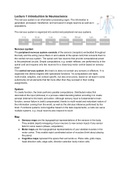Lecture 1 Introduction to Neuroscience
The nervous system is an information processing organ. The information is
generated, processed, transferred, and recovered in single neurons as well as in
populations.
The nervous system is organized into central and peripheral nervous systems.
Nervous system
The peripheral nervous system consists of the sensors (receptors) embedded throughout
the body and the wiring (nerve fibers in and outside of the spinal cord) that connects them to
the central nervous system. The spinal cord has neurons that provide computational power
to the peripheral circuits. Simple computations, e.g. certain reflexes, are performed by in the
spinal cord and requires only two neurons for a close-loop motor control based on sensory
input.
The central nervous system (the brain) is does not contain any sensors or effectors. “It is
organized into distinct regions with specialized functions.” Its computations are rapid,
multi-modal, adaptive, and context specific, but also error-prone, based on (at least in some
subcircuits) circuit elements that fail more often than they succeed in their coding
assignments.
System
To create function, the brain performs parallel computations. Distributed nodes first
deconstruct the input (stimulus) in a process called decoding before encoding it to create
percept (internal to the brain) and action. Although sensory input is fundamental to brain
function, sensor failure is (well) compansated, thanks to multi-modal and redundant nature of
the information coming from the world, as well as the stimulus inference performed by the
brain. Functional systems come together based on the task requirements, a node can serve
multiple systems. e.g. visual neurons also respond to touch
Map
● Sensory maps are the topographical representations of the sensors in the body.
They enable (rapid) remapping of your neurons to new sensor inputs if any sensor
fails for some reason (illness, amputation)
● Motor maps are the topographical representations of your skeletal muscles in the
motor cortex. They enable rapid coordinated action of muscles (think about playing
the piano)
● Cognitive maps represent the space that surrounds us. Place cells, grids maps,
head-direction cells, edge-cells, direction selection body motion cells.
,Network
Networks of neurons come together to build the maps in the brain. In the cerebral cortex
they are organized in cortical columns. In the mouse, each column has ~12K neurons,
making ~12M connections, and ~100K glia across the ~6 cortical layers. Layers have distinct
distribution of neurons and different input/output relationship with local and distant networks,
creating circuit motives.
Neurons
Neurons are compartmentalized:
● Dendrites are the principal input layer. Nonlinear integration in dendrites enable
signal detection and discrimination.
● Soma is the main electrical integration node and the center of biochemical
production.
● Axon is the output layer that provides the circuit its wiring
Synapses
Axons (most typically onto dendrites) make synapses to enable communication across
neurons. Synapses can also be found between dendrites and in soma. The synapses
mediate communication using molecules (chemical synapse) and direct ionic exchange
(electrical synapse)
,Lecture 2 Introduction to Neuroscience
Definition, identification and classification of brain regions
● by structure: neighboring cortical tissue that shows similar anatomical
organization, i.e. cytoarchitecture
● by function: a population of neurons activated by the same kind of
stimulus and/or involved in similar tasks
Anatomical study of the nervous system
The division of the CNS
The central nervous system can be divided into seven
main parts (A), and four lobes (B)
Neurons differ in shape, size, location, biochemical,
anatomical and functional organization
General rule of thumb:
1. Neurons that have local connections have
smaller soma and compact projections
2. Neurons with large soma have long distance
connections, talking to variety of structures
throughout the brain
3. Layer (L) 4 is the main input layer for most
cortical regions
4. All other layers have distinct connectivity
patterns to integrate information locally as well
as throughout the brain
, The anatomy of a neuron
Soma: The metabolic center of neurons
Dendrites: Most synapses are made into
dendritic spines which are small protrusions
coming out of dendrites.
Axon: Action potentials are generated close to
where the axon originates from soma; action
potential is regenerated along the axon to
ultimately cause neurotransmitter release from
the axonal boutons, i.e. the axonal endings,
also known as synaptic terminals.
Synapses are where neurons exchange
information. Its organization differs across
chemical and electrical synapses (more on this
in the courses Neurons & Synapses)
Neurons are classified according to the number of processes that originate from the cell
body.
Unipolar cells have a single process
emanating from the cell. Dendrites branch of
the primary axonal projection.
Bipolar cells have two independent processes
that originate from the cell body, each forming
axon or the dendrites. The two branches grow
away from each other.
Pseudo-unipolar cells are variants of bipolar
cells. They carry somatosensory information to
the spinal cord. During development axon and
dendrites fuse, resulting in a specialized cell
formation where dendrites branch off of an
axon. Multipolar cells have a single axon and
many dendrites. They are the most common
type of a neuron in the mammalian nervous
system.
Neurons are only one of the three major
classes of cells in the brain:
Others are glial cells and neuroepithelium
(observed in the walls of brain vasculature)




